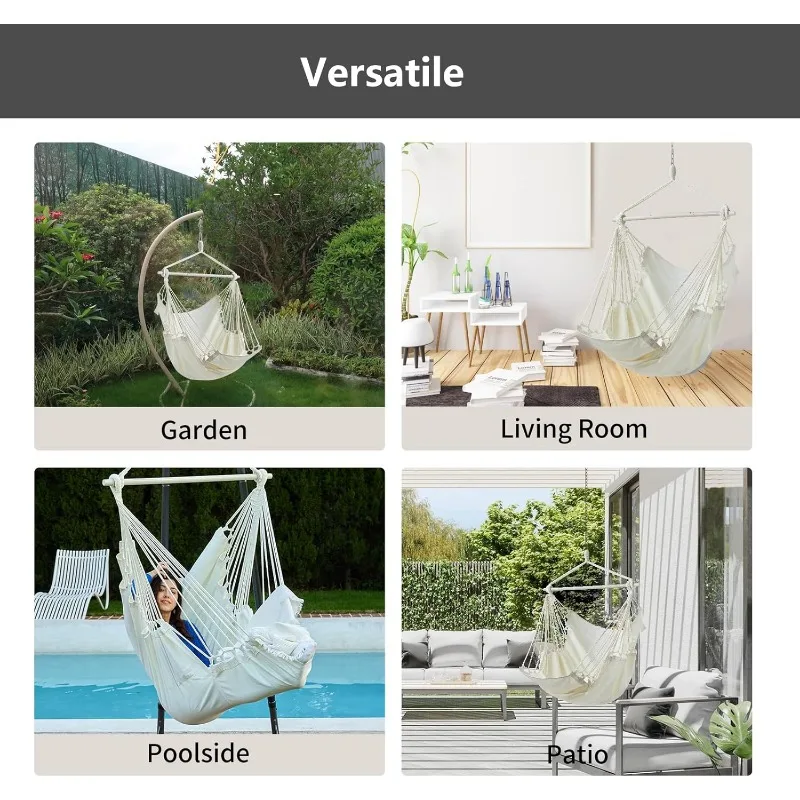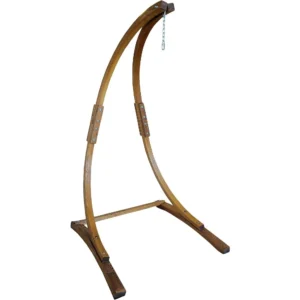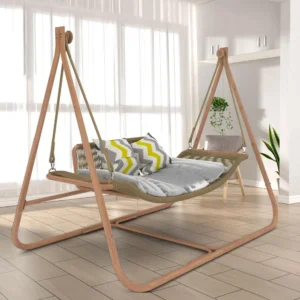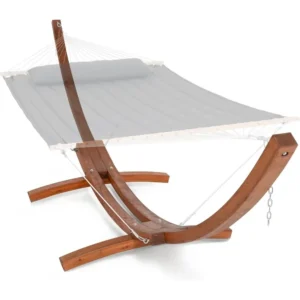Understanding the Appeal of Patio Swing Chairs
Patio swing chairs represent the perfect blend of comfort, style, and function for outdoor spaces. These suspended seating options have surged in popularity as more people seek to create personal retreats within their homes. Unlike traditional patio furniture, swing chairs offer a gentle rocking motion that transforms simple sitting into an experience of relaxation and joy.
The appeal of patio swing chairs extends beyond mere aesthetics. Research has shown that the gentle swinging motion provides notable psychological benefits:
- Reduces stress levels by activating the brain’s relaxation response
- Creates a meditative state similar to that experienced in rocking chairs
- Improves mood through gentle vestibular stimulation
- Enhances feelings of escape and retreat in your own backyard
Many homeowners find that swinging hammock chairs become natural gathering spots and conversation pieces in their outdoor spaces. Unlike stationary furniture that merely serves a function, swing chairs create an experience that engages multiple senses – the gentle motion, the cushioned comfort, and the visual appeal all combine to create a multi-dimensional relaxation zone.
The versatility of these pieces also adds to their charm. Whether installed on a small apartment balcony, a suburban backyard patio, or an expansive garden, swing chairs adapt to various outdoor environments while maintaining their distinctive appeal. The advantages of swing chairs for patios include their space efficiency, visual interest, and ability to create a focal point that elevates the entire outdoor design.
Top Material Choices for Durability and Weather Resistance
When selecting a patio swing chair, material choice becomes one of the most crucial decisions, directly impacting durability, maintenance requirements, and overall aesthetics. The right materials ensure your outdoor retreat withstands changing weather conditions while maintaining its beauty season after season.
Metal Frames: Strength and Longevity
Metal frames offer exceptional strength and stability for patio swing chairs, with distinct advantages depending on the specific metal used:
Aluminum frames provide an ideal balance of strength and practicality. These frames weigh significantly less than steel alternatives while offering impressive resistance to rust and corrosion. The lightweight nature of aluminum makes repositioning your swing chair easier while still supporting substantial weight capacities of 250-350 pounds typically.
Steel frames deliver superior strength and stability but require additional protection against the elements. Quality steel swing chairs feature powder coating technology—electrostatically applied paint that creates a hard, protective finish resistant to chipping, scratching, fading, and corrosion. This treatment extends the lifespan of steel frames significantly, often by 15-20 years with proper care.
When evaluating metal hammock chairs and stands, examine these quality indicators:
- Smooth, consistent welds at all connection points
- Uniform powder coating without bubbles or thin spots
- Stainless steel hardware for maximum corrosion resistance
- Reinforced stress points where weight distribution concentrates
One consideration with metal frames is heat retention, particularly important for chairs placed in direct sunlight. Dark-colored metal frames can become uncomfortably hot during summer months, though this can be mitigated through cushion selection and strategic placement in shaded areas.
Wood Options: Natural Beauty with Proper Care
Wooden swing chairs bring organic warmth and natural elegance to outdoor spaces. The type of wood used dramatically affects both appearance and longevity:
Teak represents the gold standard for outdoor wood furniture, containing natural oils that resist rot, insects, and weathering. These intrinsic oils allow teak to withstand decades of outdoor exposure with minimal maintenance, developing a distinguished silver-gray patina over time if left untreated. While premium teak commands higher prices, its 30+ year potential lifespan often justifies the investment.
Acacia and eucalyptus provide excellent alternatives with similar durability characteristics at more moderate price points. Both feature natural oils and dense grain patterns that resist moisture penetration, though they benefit from annual sealing to maintain optimal performance.
Cedar offers another appealing option with natural insect-repelling properties and a distinctive aromatic quality. While softer than hardwoods like teak, cedar’s lightweight nature makes it ideal for certain swing chair designs where weight becomes a consideration.
Our wooden hammocks and stands collection demonstrates how these natural materials create distinctive outdoor retreats with proper attention to:
- Smooth sanding that prevents splinters and enhances comfort
- Proper joinery techniques using mortise and tenon or dowel construction
- Quality hardware that resists corrosion when exposed to moisture
- Appropriate sealing methods that preserve natural beauty while enhancing weather resistance
The sustainability aspect of wood selection has gained importance among environmentally conscious consumers. Look for FSC certification (Forest Stewardship Council) indicating the wood comes from responsibly managed forests with controlled harvesting practices.
All-Weather Wicker and Synthetics: Modern Convenience
Synthetic materials have revolutionized outdoor furniture by combining the aesthetic appeal of traditional materials with significantly enhanced durability and minimal maintenance requirements.
PE rattan (polyethylene) replicates the appearance of natural wicker while eliminating its susceptibility to weather damage. This synthetic alternative resists moisture, prevents mildew growth, maintains color fastness under UV exposure, and requires nothing more than occasional cleaning to maintain its appearance. Quality PE rattan undergoes multiple UV stabilization treatments, allowing it to withstand 5-7 years of direct sun exposure without significant fading or brittleness.
HDPE lumber (High-Density Polyethylene) offers another synthetic alternative that mimics the appearance of painted wood while eliminating maintenance concerns. Often manufactured using recycled plastic, these eco-friendly options resist cracking, peeling, and splintering while supporting substantial weight capacities. The color permeates throughout the material rather than being surface-applied, preventing visible wear patterns even after years of use.
Our collection of hanging egg chair sets showcases how modern synthetics create distinctive silhouettes previously impossible with traditional materials. These innovative designs feature:
- Uniform weaving patterns with consistent spacing and tension
- Color-fast synthetic fibers that maintain appearance season after season
- Aluminum or steel reinforced frames concealed within the woven exterior
- Weather-resistant cushions designed specifically for outdoor exposure
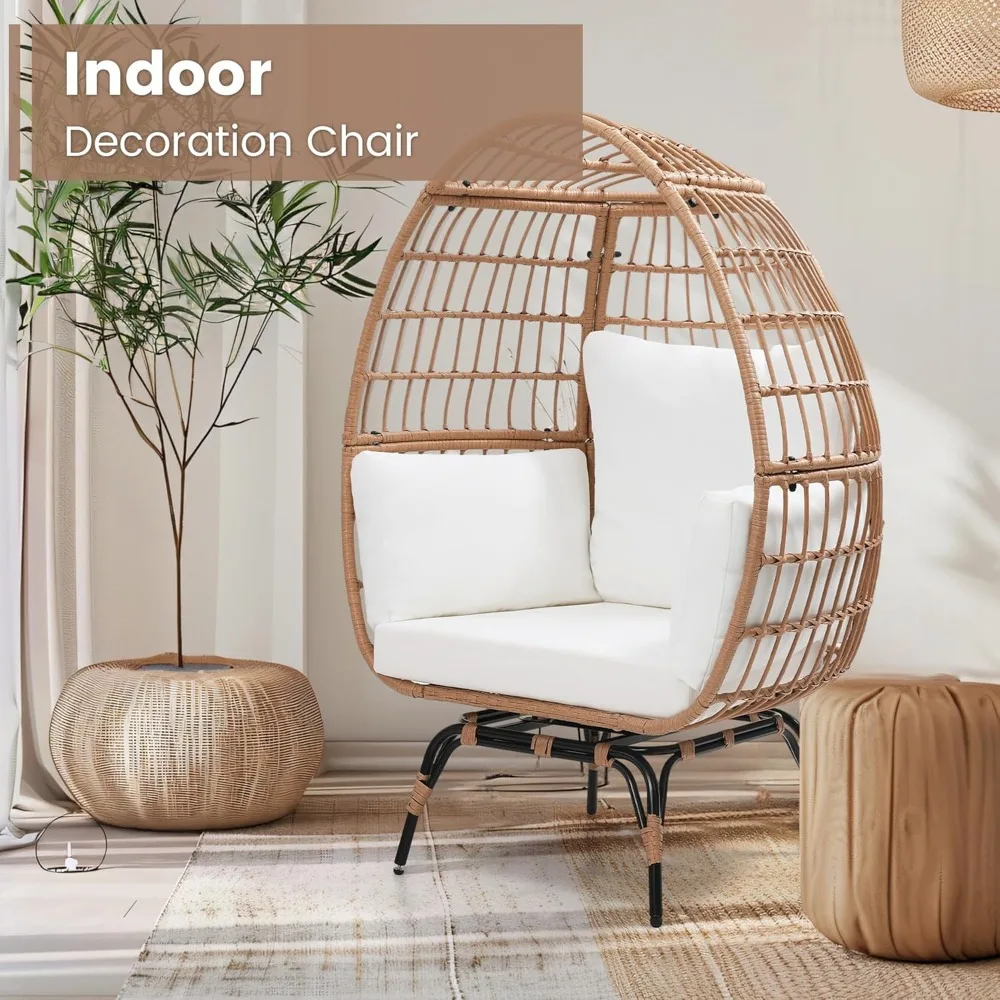
For environmentally conscious consumers, many manufacturers now offer synthetic options containing recycled materials, particularly in HDPE lumber products where post-consumer plastic waste transforms into beautiful, long-lasting outdoor furniture.
Essential Comfort Features for Maximum Relaxation
While durability ensures longevity, comfort features determine how frequently and enjoyably you’ll use your patio swing chair. The most relaxing outdoor retreats incorporate multiple elements that enhance comfort beyond basic functionality.
Cushion quality represents perhaps the most significant comfort factor, with thickness and density directly impacting the sitting experience. Premium patio swing chairs feature cushions measuring 4-6 inches thick, providing substantial support while preventing the “bottoming out” sensation found in thinner alternatives. The ideal cushion balances softness for immediate comfort with sufficient firmness to maintain support during extended relaxation sessions.
Ergonomic design elements transform adequate seating into exceptional comfort experiences. Look for these structural features that enhance body support:
- Contoured seat pans that distribute weight evenly across the sitting surface
- Lumbar support curves that maintain proper spinal alignment
- Armrests positioned at natural heights that prevent shoulder strain
- Head/neck support for full-body relaxation in reclined positions
Our deep seat chair hammock sets incorporate these ergonomic principles with dimensional specifications optimized for various body types. The ideal seat depth allows users to sit fully back while maintaining feet contact with the ground, typically measuring 21-25 inches for most adults.
Cushion Construction and Care
The materials inside your cushions significantly impact both comfort and longevity. High-resilience foams maintain their shape and support even after hundreds of compression cycles, while quick-dry technologies address moisture concerns in outdoor environments.
Quick-dry foam utilizes open-cell construction with additional channels that allow water to flow through rather than absorb, reducing drying time from days to hours after rain exposure. This technology often combines with water-resistant inner covers that provide additional protection while maintaining breathability.
Cushion fabrics require special attention for outdoor applications, with solution-dyed acrylics representing the gold standard for performance. Unlike conventionally dyed fabrics where color penetrates only the surface, solution-dyed fibers incorporate pigment throughout the material during manufacturing. This process creates colorfast fabrics that resist fading even after years of sun exposure.
The ultimate guide to egg chair cushions explains how removable, washable covers extend cushion life while simplifying maintenance. Look for these practical features in quality cushion covers:
- Hidden, heavy-duty zippers designed for frequent use
- Double-stitched seams that prevent separation under tension
- UV-resistant threads that maintain structural integrity in sunlight
- Water-repellent treatments that allow moisture to bead rather than absorb
Space Planning: Finding the Perfect Size and Fit
Proper space planning ensures your patio swing chair functions optimally while maintaining traffic flow through your outdoor area. Before selecting a specific model, measure your available space considering both the physical dimensions of the chair and its functional requirements.
The total footprint needed extends beyond the chair’s static dimensions to accommodate its natural motion. Allow a minimum clearance of:
- 24 inches behind for backward swing motion
- 24 inches in front for forward swing motion
- 12 inches on each side for stability and access
- 78-84 inches height clearance for hanging models
These clearances prevent collision with walls, railings, plants or other furniture elements during normal use. Perfectly positioning your swing hammock chair involves strategic placement that balances visibility, privacy, and protection from elements.
Weight capacity specifications provide critical safety information while indirectly indicating overall construction quality. Residential patio swing chairs typically offer capacities ranging from:
- 250-300 pounds for single-person designs
- 400-600 pounds for double-occupancy models
- 700+ pounds for larger three-person swing benches
When measuring spaces, consider how the swing chair integrates with your existing outdoor layout. Positioning near complementary elements like side tables enhances functionality, while strategic placement relative to views, shade patterns, and traffic flow optimizes the overall experience.
Stability and Safety Considerations
Safety features might not be the most exciting aspect of patio swing chair selection, but they remain absolutely essential for worry-free enjoyment. Proper attention to stability and structural integrity prevents accidents while ensuring confident relaxation.
Freestanding swing chair designs utilize either a weighted base or a balanced frame structure to maintain stability during use. Quality models feature:
- Wide base dimensions that create a stable footprint
- Low center of gravity that resists tipping forces
- Counter-balancing elements strategically positioned for maximum stability
- Anti-tip features that activate under excessive motion
For hanging models, proper installation becomes critical for both safety and performance. Ultimate swinging chair installation techniques vary depending on mounting location, with ceiling joists, exposed beams, or tree limbs requiring specific hardware and approaches. Professional installation may be advisable for complex situations involving uncertain structural elements.
Critical safety hardware includes:
- Stainless steel spring hooks with safety latches that prevent accidental disconnection
- Heavy-duty chains or rope systems rated at minimum 600-pound capacity (regardless of chair weight capacity)
- Sealed bearings in swivel mechanisms that maintain smooth operation without pinch points
- Locking mechanisms that can limit motion when desired
Regular inspection remains essential regardless of model type or installation method. Check all connection points, weight-bearing elements, and moving parts monthly during peak usage seasons, giving special attention to areas where moisture might accelerate wear.
Weather Protection Features
Extending your patio swing chair’s usable season requires thoughtful weather protection features that guard against sun damage, moisture intrusion, and temperature extremes. These protective elements enhance both comfort and longevity.
Canopy systems represent the most visible weather protection, providing shade that reduces UV exposure for both occupants and materials. Quality canopies feature:
- UPF 50+ fabrics that block 98% of harmful UV radiation
- Water-resistant treatments that provide light rain protection
- Ventilation elements that reduce wind stress and heat buildup
- Adjustable positioning to track the sun’s movement throughout the day
Comprehensive weather protection for patio hammock chairs extends beyond visible elements to include water management features like drainage holes in seat designs and breathable materials that resist moisture retention. These thoughtful details prevent mildew development and structural degradation from trapped moisture.
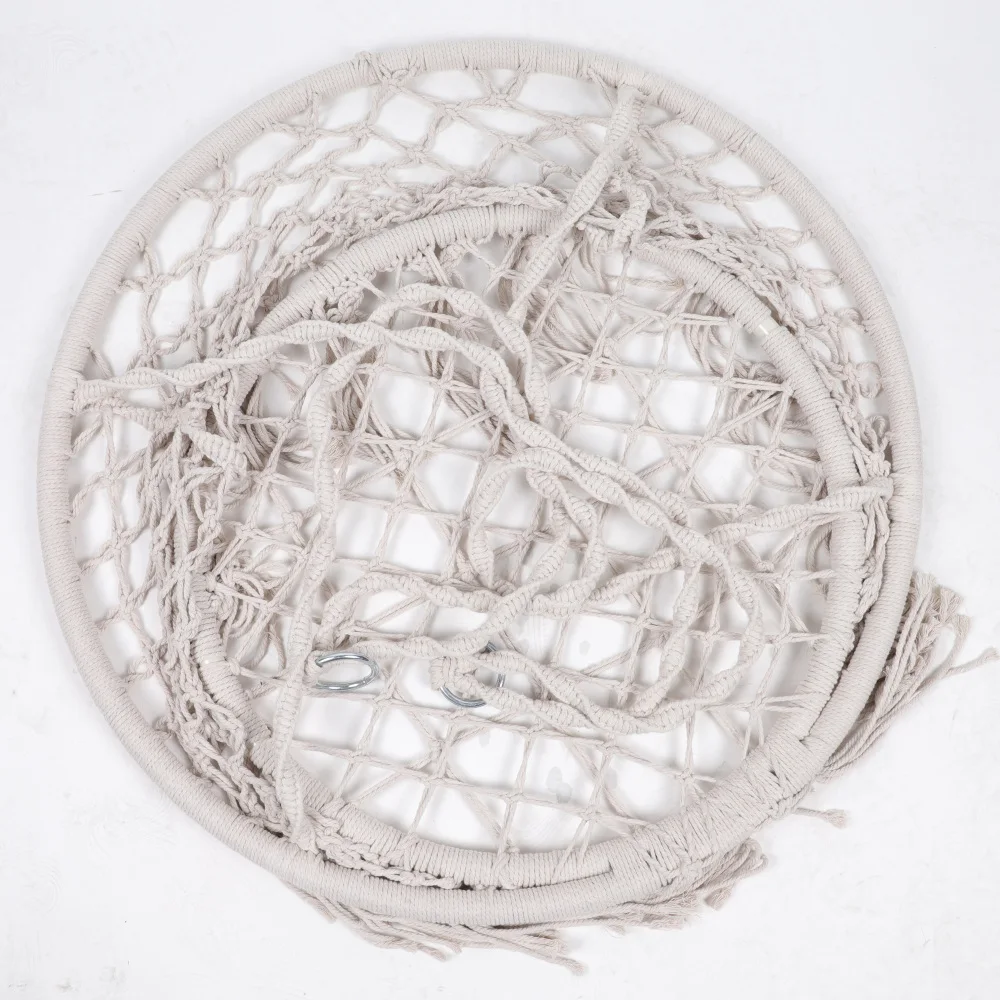
For maximum protection in challenging climates, consider hammock sets with canopy designs that provide integrated shelter without sacrificing aesthetic appeal. These coordinated systems ensure compatible function between the seating element and its protective features.
Seasonal considerations should influence both selection and usage patterns. While full-season models designed for year-round exposure exist, many swing chairs benefit from storage during extreme weather periods. Consider how protective covers, detachable elements, and storage requirements align with your climate and available space.
Style and Design Elements to Complement Your Outdoor Space
Your patio swing chair makes a significant visual statement while expressing your personal style. Beyond pure functionality, these distinctive pieces establish aesthetic direction through form, material, color, and detailing.
Distinct design categories offer starting points for selection:
- Modern styles feature clean lines, minimalist structures, and contemporary materials like powder-coated metals and synthetic weaves
- Bohemian designs emphasize natural materials, handcrafted details, macramé elements, and organic silhouettes
- Traditional approaches utilize classic forms, symmetrical elements, and time-tested materials like wood and woven wicker
- Coastal aesthetics incorporate weathered finishes, nautical references, and airy, light-colored materials
Color selection significantly impacts both aesthetic integration and practical performance. Frame colors establish visual weight and style direction, while cushion fabrics offer opportunities for seasonal refreshes and accent colors that complement your overall outdoor color scheme.
Our swinging hammock chair sets collection demonstrates how coordinated designs create cohesive outdoor retreats rather than isolated furniture pieces. Consider how your swing chair relates to existing elements like:
- Architectural features of your home (rooflines, window styles, exterior materials)
- Established plantings and landscape design approaches
- Complementary outdoor furniture pieces
- Overall color schemes and decorative direction
The emotional impact of design extends beyond visual appeal to influence how the space feels. Consider how different styles evoke specific emotional responses—modern designs often convey sophistication and contemporary relevance, while bohemian approaches suggest relaxed authenticity and creative expression.
Innovative Features Worth Considering
Modern patio swing chairs incorporate innovative features that enhance both comfort and functionality. These thoughtful additions transform basic seating into personalized relaxation experiences tailored to specific preferences.
Enhanced motion options extend beyond basic swinging to include:
- 360° swivel mechanisms that allow repositioning without standing
- Gentle gliding motions that offer horizontal movement alternatives
- Rocking capabilities that provide traditional forward-back comfort
- Reclining functions that adjust positioning for reading versus napping
Convenience elements integrate practical solutions into relaxation spaces:
- Side tables or surfaces for beverages and small items
- Built-in cup holders that prevent spills during movement
- Hidden storage compartments for books, devices, or outdoor essentials
- Adjustable elements that accommodate different users and activities
Patio-friendly swinging hammock chairs increasingly incorporate technology integration with features like:
- Solar-powered LED lighting for evening ambiance
- Weather-resistant Bluetooth speakers for audio enjoyment
- USB charging ports for device convenience
- Smart home compatibility for coordinated outdoor experiences
Multi-functional designs address space limitations by serving multiple purposes, such as convertible models that transform from upright seating to horizontal lounging positions. These versatile pieces maximize value by adapting to different users and usage scenarios throughout the day.
Essential Maintenance for Longevity
Proper maintenance significantly extends the lifespan of your patio swing chair while preserving its appearance and functionality. Establishing seasonal care routines prevents minor issues from developing into significant problems.
Regular cleaning requirements vary by material:
- Metal frames benefit from monthly wipedowns with mild soap and water, with special attention to joints and connections where moisture might accumulate
- Wood elements require cleaning with appropriate wood-specific products that remove dirt without stripping protective finishes
- Synthetic materials generally need simple soap and water cleaning, though pressure washing should be avoided as it may damage fibers

Hardware inspection should become routine, checking for:
- Loose fasteners that require tightening
- Signs of corrosion requiring treatment or replacement
- Wear patterns in chains, ropes, or connection points
- Stress indicators in weight-bearing components
Cushion care significantly impacts both appearance and longevity. Removable covers should be washed according to manufacturer specifications, typically allowing machine washing in cold water with mild detergent. Air drying prevents shrinkage issues common with heated drying methods.
Dark Wood Hammock Sets, Porch Swing Chair Sets
$653.82 Select options This product has multiple variants. The options may be chosen on the product pageA-Frame Stand Hammock Sets, Swinging Hammock Chair Sets
$154.62 Select options This product has multiple variants. The options may be chosen on the product pageLight Wood Hammock Sets, Swinging Hammock Chair Sets
$1,359.35 Select options This product has multiple variants. The options may be chosen on the product pageClassic Wooden Stand Hammock Sets, Heavy Duty Hammock Sets
$1,061.68 Select options This product has multiple variants. The options may be chosen on the product pageHammock Sets with Canopy, Heavy Duty Hammock Sets
$286.31 Select options This product has multiple variants. The options may be chosen on the product pageHeavy Duty Hammock Sets, Wooden Arc Stand Hammock Sets
$878.66 Select options This product has multiple variants. The options may be chosen on the product page
Seasonal transitions require specific attention, particularly when storing components during winter months. Ensure all elements are thoroughly clean and dry before storage, and use breathable covers that prevent moisture accumulation while protecting from dust and debris.
How to Evaluate Quality Before Purchasing
Distinguishing between average and exceptional patio swing chairs requires attention to specific quality indicators that predict long-term performance. These evaluation criteria help identify pieces worthy of investment.
Material quality reveals itself through:
- Consistent coloration and texture throughout surfaces
- Precision cutting with smooth edges and uniform dimensions
- Appropriate weight that indicates substantial construction
- Material thickness that resists bending or flexing under pressure
Construction details provide further quality evidence:
- Reinforced stress points where maximum weight bears during use
- Double stitching on cushion seams exposed to tension
- Smoothly operating mechanisms without binding or excessive play
- Precise fitting of components without gaps or misalignments
Hardware quality often distinguishes premium options:
- Stainless steel fasteners rather than plated alternatives
- Sealed bearings in moving components that resist moisture intrusion
- Thick, substantial metal gauges in support elements
- Hidden structural reinforcements at connection points
The best patio hammock swing chairs typically come with warranties reflecting manufacturer confidence. While specific terms vary, quality indicators include:
- Frame warranties extending 3-5 years minimum
- Fabric coverage of at least 1-2 years
- Clear, specific language rather than vague guarantees
- Prorated coverage that provides partial replacement value as products age
Creating Your Perfect Outdoor Retreat with a Patio Swing Chair
Transforming your outdoor space into a personal retreat involves thoughtful planning beyond simple furniture placement. Your patio swing chair becomes the centerpiece of an intentionally designed relaxation zone tailored to your specific preferences.
Strategic placement maximizes enjoyment by considering:
- Morning versus afternoon sun exposure based on your usage patterns
- Proximity to outdoor dining or conversation areas for integration or separation
- Visual focus points like gardens, water features, or landscape views
- Privacy from neighboring properties or street visibility
Accessorizing enhances both comfort and personalization through:
- Weather-resistant throw pillows that introduce accent colors and patterns
- Outdoor rugs defining the space and adding textural interest
- Side tables providing convenient surfaces for beverages and personal items
- Lighting elements that extend usability into evening hours
Creating a perfect hammock haven involves layering elements that engage multiple senses. Consider introducing:
- Scented plants like jasmine or lavender near your swing chair
- Water features providing gentle background sounds
- Wind chimes offering subtle audio elements
- Outdoor-safe fabrics with interesting textural qualities
The space surrounding your swing chair significantly impacts the overall experience. Consider establishing planting barriers for privacy, installing shade elements for comfort, and incorporating nature through container gardens or vertical plantings that enhance the retreat atmosphere.
Weather Considerations and Seasonal Care
Different seasons present unique challenges and opportunities for patio swing chair enjoyment. Adapting your approach to seasonal conditions ensures year-round satisfaction with your outdoor retreat.
Winter Storage Solutions
Q: Do I need to store my swing chair during winter months?
A: Material determines storage requirements. While synthetic all-weather materials can withstand winter exposure in many climates, wood and metal pieces benefit from protection during extreme conditions. If storage space allows, indoor placement extends lifespan regardless of material.
Q: What’s the best way to prepare cushions for storage?
A: Thoroughly clean and completely dry all fabric elements before storage. Use breathable containers rather than sealed plastic, which can trap moisture and promote mildew growth. Cedar blocks or lavender sachets naturally deter pests during storage periods.
Summer Protection Strategies
Q: How can I prevent sun fading during peak summer months?
A: Consider removable shade options like clip-on umbrellas or sun sails when not using integrated canopies. Repositioning during extreme heat periods reduces material stress, while fabric protectant sprays provide additional UV defense for cushions.
Our porch swing chair sets include considerations for year-round usage with materials selected for climate adaptability. Seasonal maintenance should include:
- Spring: Deep cleaning, hardware tightening, and finish inspection
- Summer: Regular cushion rotation and sun protection assessment
- Fall: Weather sealing of wood components and frame inspection
- Winter: Proper storage or protective covering installation
Comparing Standalone vs. Hanging Swing Chairs
The choice between standalone and hanging swing chair designs significantly impacts installation requirements, motion quality, and placement flexibility. Each approach offers distinct advantages worth considering.
| Feature | Standalone Swing Chairs | Hanging Swing Chairs |
|---|---|---|
| Installation Complexity | Minimal – typically simple assembly only | Moderate to Complex – requires secure mounting point |
| Motion Quality | Controlled, often limited to specific directions | Free-flowing, more natural swinging experience |
| Space Requirements | Larger footprint including base/frame | Smaller footprint but needs overhead clearance |
| Portability | Moderately portable between locations | Fixed installation with limited mobility |
| Weight Capacity | Generally higher due to stable base | Limited by mounting structure strength |
The motion experience differs noticeably between types. Standalone models deliver more controlled, predictable movement often limited to specific directions defined by the frame design. In contrast, hanging models offer multi-directional freedom with a more substantial “floating” sensation many users prefer.
Installation considerations often become deciding factors. Standalone options require only stable, level surfaces, while hanging chairs demand structural support capable of safely bearing dynamic loads exceeding the chair’s static weight. For many users without suitable mounting options, swing hammocks versus patio chairs presents a practical decision based on structural limitations rather than pure preference.
Placement flexibility remains another key differentiator. Standalone models can be repositioned seasonally to optimize sun exposure or views, while hanging installations commit to specific locations semi-permanently. This distinction particularly matters in regions with significant seasonal variations affecting outdoor comfort zones.

